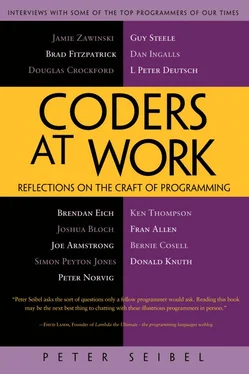Peter Seibel - Coders at Work - Reflections on the craft of programming
Здесь есть возможность читать онлайн «Peter Seibel - Coders at Work - Reflections on the craft of programming» весь текст электронной книги совершенно бесплатно (целиком полную версию без сокращений). В некоторых случаях можно слушать аудио, скачать через торрент в формате fb2 и присутствует краткое содержание. Жанр: Программирование, на английском языке. Описание произведения, (предисловие) а так же отзывы посетителей доступны на портале библиотеки ЛибКат.
- Название:Coders at Work: Reflections on the craft of programming
- Автор:
- Жанр:
- Год:неизвестен
- ISBN:нет данных
- Рейтинг книги:3 / 5. Голосов: 1
-
Избранное:Добавить в избранное
- Отзывы:
-
Ваша оценка:
- 60
- 1
- 2
- 3
- 4
- 5
Coders at Work: Reflections on the craft of programming: краткое содержание, описание и аннотация
Предлагаем к чтению аннотацию, описание, краткое содержание или предисловие (зависит от того, что написал сам автор книги «Coders at Work: Reflections on the craft of programming»). Если вы не нашли необходимую информацию о книге — напишите в комментариях, мы постараемся отыскать её.
Coders at Work
Founders at Work
Coders at Work: Reflections on the craft of programming — читать онлайн бесплатно полную книгу (весь текст) целиком
Ниже представлен текст книги, разбитый по страницам. Система сохранения места последней прочитанной страницы, позволяет с удобством читать онлайн бесплатно книгу «Coders at Work: Reflections on the craft of programming», без необходимости каждый раз заново искать на чём Вы остановились. Поставьте закладку, и сможете в любой момент перейти на страницу, на которой закончили чтение.
Интервал:
Закладка:
In my experience, the worst bugs are the real-time bugs, which have to do with interactions with multiple threads. My approach to those bugs is to avoid making them. So I don’t like threads. I think threads are an atrocious programming model. They’re an occasionally necessarily evil, but they’re not necessary for most of the things we use threads for.
One of the things I like about the browser model is that we only get one thread. Some people complain about that—if you lock up that thread, then the browser’s locked up. So you just don’t do that. There are constantly calls for putting threads into JavaScript and so far we’ve resisted that. I’m really glad we have.
The event-based model, which is what we’re using in the browser, works really well. The only place where it breaks down is if you have some process that takes too long. I really like the approach that Google has taken in Gears to solving that, where they have a separate process which is completely isolated that you can send a program to and it’ll run there. When it’s finished, it’ll tell you the result and the result comes back as an event. That’s a brilliant model.
Seibel:Have you ever been interested in formal proofs?
Crockford:I watched it closely during the ’70s, looking to see if they were going to come up with anything. And I didn’t see it paying off. Software is so complicated and can go wrong in so many ways.
Basically, software is the specification for how the software is supposed to work. And anything less than the complete specification doesn’t really tell you anything about how it’s ultimately going to behave. And that just makes software really, really hard.
Seibel:How do you test code? Are you, as they say these days, testinfected?
Crockford:I tend to be more ad hoc. That’s another place where I’m considering changing my style, but I haven’t accomplished that yet.
Seibel:There is a JsUnit, right?
Crockford:There is a JsUnit. Testing of UI code is really difficult because it’s really dependent on a whole lot of stuff, so breaking it down into units tends to be less effective. Also, I found because of the style that I’m writing in JavaScript, it doesn’t break in an orderly way into units the way classes do, so you can think about testing a class in isolation.
In JavaScript, testing a function in isolation maybe doesn’t make much sense because there’s the state that it needs in order to be interesting. I haven’t figured out a sufficiently useful way of testing units of JavaScript yet.
Seibel:In places that have separate QA groups, how should developers and QA groups work together?
Crockford:I’ve had companies where there was an antagonism between the development teams and the testing teams, which I thought was extremely unhealthy. There was this theory that you keep the two separate and one would rat out the other, basically. And I just think it’s a horrible model.
It worked much better when we put the two teams together and made the testers responsible for helping the developers to make their programs better, rather than ratting out the developers. It changed the way they reported and was much more effective. Also, cycling the developers into testing, so you weren’t exclusively one or the other.
The place where I found that to be most effective was taking testing, sort of, to the ultimate: going to visit customers. I did some of that early in my career and that was a great experience, having to go live with a customer for a week, helping them to install a new system, and helping them to work out the problems with using it.
It gave me a huge amount of insight into what it’s like to actually use our stuff and what I want to be doing for the benefit of the people who are going to be using my stuff. Going back afterwards, developers who had not had that experience all seemed arrogant to me in a way which was completely inexcusable. The lack of respect they had for the people who used our stuff was appalling and it was basically a consequence of their having never met those people.
Seibel:Do you consider yourself a scientist, an engineer, an artist, a craftsman, or something else?
Crockford:I think of myself as a writer. Sometimes I write in English and sometimes I write in JavaScript.
It all comes down to communication and the structures that you use in order to facilitate that communication. Human language and computer languages work very differently in many ways, but ultimately I judge a good computer program by its ability to communicate with a human who reads that program. So at that level, they’re not that different.
Seibel:And if it can communicate well to a human, you feel like the communicating-with-the-computer part will fall out?
Crockford:You hope so. Computers are arbitrary and not very smart, so you have to make special efforts to make sure that they get it. Because that’s so hard, it’s easy to overlook the other part, but I think it is at least as important.
Seibel:So Dijkstra had a famous paper, “On the cruelty of really teaching computing science,” that basically said computer programming is a branch of applied math. Do you agree?
Crockford:Mathematics is important in programming, but it’s just one of a lot of things that are important. I think if you overemphasize the math then you underemphasize stuff which might be even more important, such as literacy.
I mentioned I wanted to have the hiring requirement that they had to have read Knuth and I couldn’t do that because I couldn’t find enough people who had. The other thing I wanted was that they be really literate in whatever language they write to other humans. I want people who can write, because we spend a lot of time writing to each other. We’re writing email or documentation. We’re writing plans. We’re writing specifications. I want to know that the people on my team are capable of doing that, and that turns out to be a really difficult skill. So I would actually rather see people start as English majors than as math majors to get into programming.
Seibel:I think Dijkstra had another quote about that along the lines of, “If you can’t write in your native language, give it up.”
Crockford:I agree with that one.
Seibel:An aspect of programming that you seem to keep running up against is that while we are unbound by physical constraints we get tied down by accidents of history. A lot of your proposals for subsetting JavaScript and your version of HTML5 seem to be attempts to fix these kinds of historical accidents.
Crockford:Yeah, and some of it is quixotic. I know that a lot of the things that I’m hoping to accomplish are not achievable. I’m aware of that. But every once in a while something works. Like when XML was proposed as a data-interchange format, my first impression of that was, “My god, this is way, way, way too complicated. We don’t need all of this stuff just to move data back and forth.” And so I proposed another way to do it, and it won. JSON is now the preferred way of doing data transfer in Ajax applications and it’s winning in a whole lot of other applications. And it’s just really simple. So that restores my faith in humanity, that maybe we can finally get some of these things right.
But you can’t have everybody going off, making up their own thing. That doesn’t work. That doesn’t do anybody any good. But one person has to make up a thing and everyone else has to figure out how to agree which one of those we’re all going to get behind. JSON was a different kind of accident of history.
Читать дальшеИнтервал:
Закладка:
Похожие книги на «Coders at Work: Reflections on the craft of programming»
Представляем Вашему вниманию похожие книги на «Coders at Work: Reflections on the craft of programming» списком для выбора. Мы отобрали схожую по названию и смыслу литературу в надежде предоставить читателям больше вариантов отыскать новые, интересные, ещё непрочитанные произведения.
Обсуждение, отзывы о книге «Coders at Work: Reflections on the craft of programming» и просто собственные мнения читателей. Оставьте ваши комментарии, напишите, что Вы думаете о произведении, его смысле или главных героях. Укажите что конкретно понравилось, а что нет, и почему Вы так считаете.












